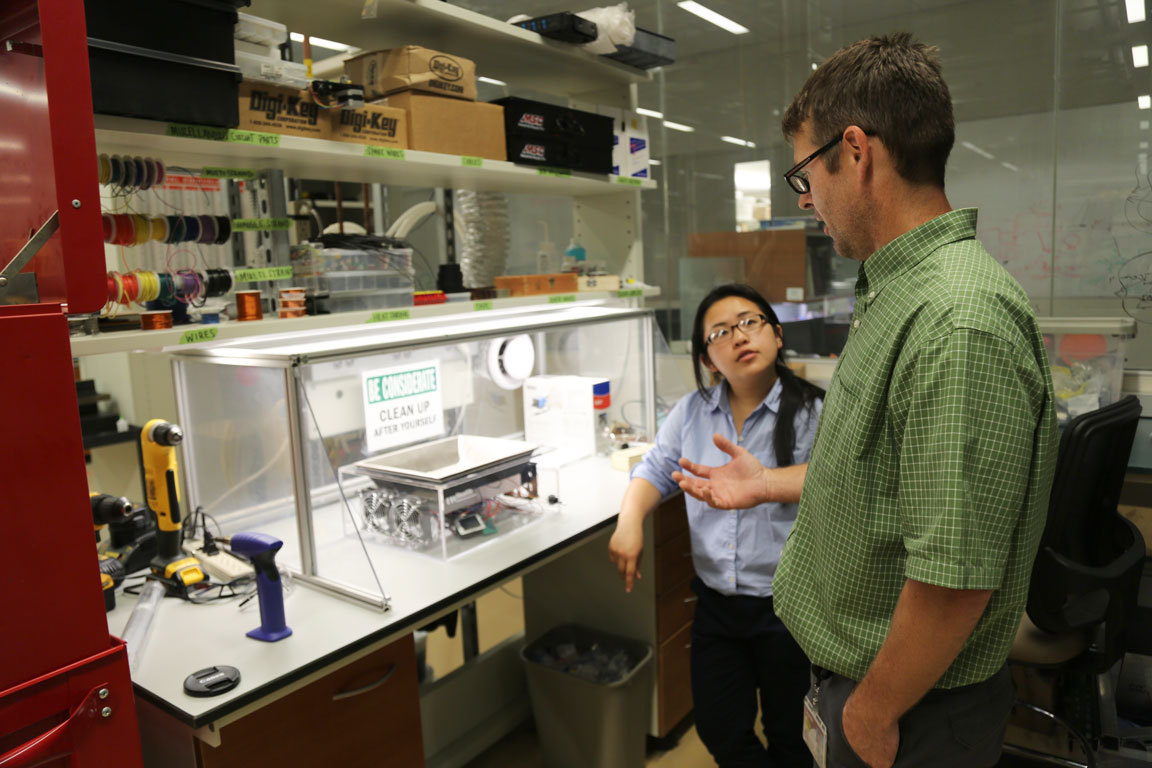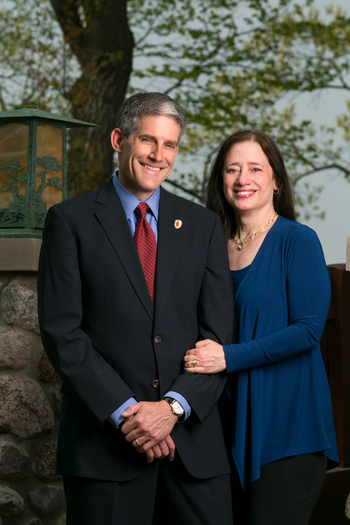Gift to Morgridge Institute ‘Fab Lab’ to boost medical device innovations

Fab Lab mechanical engineer Robert Swader and biomedical engineering student Annie Yang discuss a prototype in development to maintain health of organs prior to transplant.
Photo: Morgridge Institute for Research
A gift to the Morgridge Institute for Research will help spur medical device innovations coming directly from doctors — the people who know firsthand where the advances are needed.
The BerbeeWalsh Foundation, created by James Berbee and Karen Walsh, has made a five-year, $300,000 commitment to create a prototype pathway for clinical devices between University of Wisconsin–Madison clinicians, students and the Morgridge Advanced Fabrication Laboratory, or “Fab Lab.”
Berbee, a clinical assistant professor in the UW–Madison Department of Emergency Medicine and Morgridge trustee, says the gift isn’t restricted to medical prototypes, but the early focus is on tapping experiences from doctor-patient interactions, starting with his home department.
“We are looking in emergency medicine to be a little more proactive in thinking about product designs and the tools we need to do our jobs well,” Berbee says. “So we thought this would be a great bridge between Morgridge and the department, as an initial test bed for expanding the scope of the Fab Lab.”

James Berbee and Karen Walsh
The gift is a natural fit for the Madison couple. In Berbee’s “first career,” he was a UW–Madison engineering graduate who founded the highly successful Berbee Information Networks in Madison in 1993. Walsh, as an assistant dean at the UW–Madison College of Engineering in the 1990s, helped launch UW–Madison’s first-ever campus innovation prize, the Schoofs Prize for Creativity, which had a transformational impact on hundreds of students.
“What’s really exciting about this project is its potential to improve patient care by unlocking great ideas from people at the front lines of medical care,” says Morgridge CEO Brad Schwartz. “Our Fabrication Lab can help people develop proof of concept, remove barriers and take those important early steps toward commercialization.”
Kevin Eliceiri, interim director of Morgridge Medical Engineering and the Fab Lab, says this project will build on some medical ideas already percolating in the lab. For example, they are working on a more effective way to maintain health of organs prior to transplant and a feedback sensor to warn of possible injury when installing breathing tubes. Two biomedical engineering student teams used the Fab Lab to perfect inventions that won campus business plan competitions, including a new anesthesia applicator and a tool to prevent recurrence of bladder cancer.
Students will be top beneficiaries of the gift, he says. “We have a great pipeline of talented students who want to work on biomedical projects and are very passionate about it,” Eliceiri says. “Their only complaint has been that they want things that are more clinically relevant.”
“Medical students don’t get encouraged to invent because they have so many other things to think about. Those little ideas can cook in the brain and never get out — but if we give them an outlet, they will.”
Karen Walsh
Rather than bringing students in as one-time participants, this effort will embed them as full members of the Fab Lab team, to work closely with clinicians through the whole research and invention process, Eliceiri says. They also are exploring whether medical residents, who have a select amount of time each year for elective experience, could elect to serve as research fellows at the Fab Lab.
“I expect this program to have a great impact and generate a fair amount of intellectual property,” Eliceiri says. Participants can tap well-established connections between the Fab Lab and the Wisconsin Alumni Research Foundation (WARF) to get timely IP support.
Part of the inspiration for the gift came from Berbee’s own invention of a new type of otoscope, a cone-shaped device to view the inner ear. The current tool — something in virtually every doctor’s office — performs poorly and hasn’t been improved upon for a century. Berbee developed a flexible optic lighting module that provides much sharper resolution. He received help with an early prototype from the Fab Lab.
“There’s a whole subculture of people in the medical school who are interested in this type of innovation,” he says. “You don’t hear about it much because their primary focus is on taking care of patients, teaching and research. But people are starting to respect that this is another path to success.”
Adds Walsh: “Medical students don’t get encouraged to invent because they have so many other things to think about. Those little ideas can cook in the brain and never get out — but if we give them an outlet, they will.”
The Morgridge Fab Lab collaborates with inventors on computer-aided design, prototyping, 3-D printing, microfluidics and fabrication, from conception to completion. The campuswide facility can assist with the more experimental phases of a research effort by generating early-stage prototypes and novel research tools.
—Brian Mattmiller




